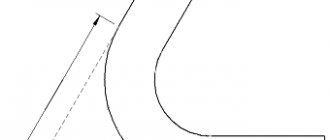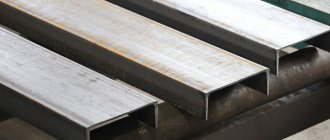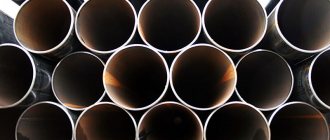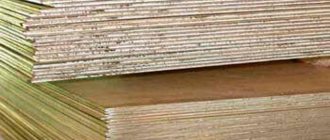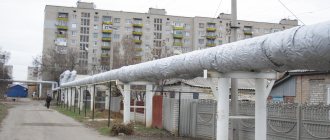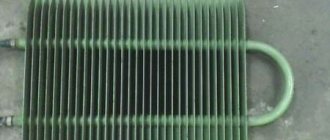Why do you need to calculate pipes?
In most cases, there is a need to calculate the sizes and proportions of pipes in advance. This may be necessary for good communication with other systems.
It is important for builders to focus on this:
- How passable;
- Heat loss;
- How much insulation;
- How many anti-corrosion materials;
- How rough are the pipes?
Calculation of pipe sizes
In order to calculate everything accurately and accurately, it is important to first measure these indicators:
- What are the pipes made of?
- What section;
- What are the diameters?
- How thick are the walls;
- How long.
Some of this data is written on the pipe certification document, in reference materials or GOST.
Applying the calculation formula
Information about the squaring of the outer surface of a round figure is necessary for designers, estimators, installers and equipment maintenance and repair specialists, for example, when solving problems:
1. The volume of thermal energy of the “warm floor” structure or heating radiators.
2. Body losses during transportation from the point of delivery to the border of the balance sheet of the networks.
3. The amount of costs for protecting metal from corrosion. The main elements are coated with paint and bitumen varnish. Accurate calculation of the area will prevent inappropriate use of paint.
4. Quantity and cost of insulating material. For example, the distance from the thermal power plant collector to a residential village is 2 kilometers. The length of the residential area is three kilometers. A total of 5 kilometers of backbone networks will require insulating material. The area needs to be calculated without wasting money on the purchase of mineral wool, fiberglass and aluminum foil.
The inside of the pipe is not painted or insulated. But to calculate the speed of water movement, you need to know the internal area. In main water pipelines with a diameter of 1.4 m, the friction of water against the internal walls can be neglected. But on structures with a diameter of 20-30 cm, after 10 years of operation, salt deposits are recorded. Corrosion worsens the condition of the internal walls, and the speed of water flow decreases.
Calculation of diameter with volume
The calculation formulas are simple and are studied at school. In order to find out the diameter of the pipe, you first need to calculate the circumference. A centimeter ruler will come to the rescue.
If it is not there, you can wrap the pipe with regular thread and then use a ruler to measure the length.
Circumference formula:
- L=n*D,
- L is the sign of the circumference;
- n is the sign of the constant number PI (3.1415);
- D is the sign for the diameter of the circle.
By changing the formula a little, you can calculate the diameter of the pipeline:
- D=L/p
After measuring the thickness of the pipes, you can easily find out the internal diameter. You just need to subtract the thickness multiplied by two from the diameter of the outer side.
Calculation of pipe cross-sections
Before finding out, you need to find out the area of the circle. But it is important to take into account the difference in outside diameter and wall thickness.
Formula for calculating area:
- S=n*R²,
- S - area sign;
- n — PI sign (3.1415);
- R is the radius sign.
If outside diameter and thickness values are used for calculations, it is worth using this formula:
- S=n*(D/2-T)²,
- S is the sign of the cross-sectional area;
- n — PI sign (3.1415);
- D - outside diameter sign;
- T is the sign of thickness.
If the diameter outside the pipe is 3 meters, the thickness is 15 millimeters. First of all, everything needs to be coordinated, that is, the millimeter must be converted into a meter. It turns out that the thickness is 0.015 meters.
Next you need to apply the formula for calculation:
- S=3.141*(3/2-0.015m)²=4.66m²
- It turns out that the cross-section of the pipes is 4.66 m2.
How accurate the calculations will be depends on the number pi. But during the construction process there is no need to calculate everything exactly. The number "pi" can be taken as 3.141. And the final number must be reduced to two digits after the decimal point.
How to calculate cross-sectional area
Formula for finding the cross-sectional area of a round pipe
If the pipe is round, the cross-sectional area should be calculated using the formula for the area of a circle: S = π*R2. Where R is the radius (internal), π is 3.14. In total, you need to square the radius and multiply it by 3.14.
For example, the cross-sectional area of a pipe with a diameter of 90 mm. We find the radius - 90 mm / 2 = 45 mm. In centimeters this is 4.5 cm. We square it: 4.5 * 4.5 = 2.025 cm2, substitute it into the formula S = 2 * 20.25 cm2 = 40.5 cm2.
The cross-sectional area of a profiled pipe is calculated using the formula for the area of a rectangle: S = a * b, where a and b are the lengths of the sides of the rectangle. If we consider the cross-section of the profile to be 40 x 50 mm, we get S = 40 mm * 50 mm = 2000 mm2 or 20 cm2 or 0.002 m2.
Calculation of internal volume
For this type of calculation, it is necessary to know the area of the circle based on the outer diameter.
This area is found using the following formula:
- S=n*R² or S=n*(D/2)²,
- S - area sign;
- n — PI sign (3.1415);
- D is the sign of the outer diameter.
The resulting number must be multiplied by the length of the segment. This way the volume is found, which is expressed in meters per cube.
The calculation formula looks like this:
- V=S*H:
- V - volume sign;
- S - area sign;
- H is the sign of the length of the segment.
If you have a pipe with an outer diameter of 55 centimeters and a length of 3 meters, you can easily measure the volume. First you need to convert all values to one unit of measurement, that is, meters. 55 centimeters turns into 0.55 meters.
Now all that remains is to substitute the available values into this formula and calculate using a calculator:
- S=n*(D/2)² = 3.141*(0.55/2)²=0.075m²
It remains to use the second formula:
- V=S*H = 0.075*3=0.226m³
Heat preservation
Insulation of heating pipes reduces heat loss not only in the central line, but also in the bulk room, where the route between the heating boiler and living rooms passes through cold auxiliary rooms.
The difference between insulation materials in terms of thermal conductivity and installation method requires selection taking into account the installation location and the properties of the material. Manufacturers offer several types of insulating element:
- glass wool in cut rolls; after wrapping it around the pipe, it is tightened with wire and covered on top with aluminum foil or roofing felt;
- basalt wool in plates; installation technology similar to glass wool;
- flexible pipe made of foamed foil polyethylene with a cut along the product for installation; used for internal engineering networks;
- Liquid thermal insulation is used on already laid pipelines, when there is no room for maneuver with other materials.
- polystyrene foam in the form of two detachable pipe halves; during installation, the shell halves are put on the pipe, aligned and secured with construction tape; Foam insulation is used repeatedly.
The square footage of the covering material depends on the thickness of the insulation. The formula for the surface area of thermal insulation in the case under consideration looks like this:
P = 3.14159 * D * T * K, where
D – outer diameter of the pipe;
K is a variable correction factor for the thickness of the insulation.
Construction calculators have been developed to calculate the area of insulation.
Calculation of pipe mass
Weight data will allow you to find out how much money will need to be invested in transporting pipes. Mass is found by multiplying the volume by the density of the substance from which it is made.
To carry out all the necessary calculations, you need to know about several important data about the pipe:
- What material is it made of?
- What are the external and internal diameters?
- How thick are the walls?
First, the mass of 1 linear meter is calculated. And to find out the total mass, the resulting number is multiplied by the total number of linear meters.
Having collected all the necessary data, you should use a special calculator.
When might this come in handy?
You should start by identifying cases where such calculations may be useful:
They can be useful if it is necessary to calculate heat transfer through a pipeline. All this is calculated based on the surface area that transfers thermal energy from the coolant to the environment. It is often necessary to determine the loss of thermal energy on the way to the heating device. All this will allow you to determine the required number and dimensions of radiators. To do this, we need to know how many calories we have at our disposal. The calculation is also made based on the area of the corresponding surface of the pipeline through which the coolant is transported from the elevator unit.
In order to determine the required volume of thermal insulation material, the external surface area should also be determined. In this case, the more accurate the calculation, the higher the savings on the purchase of material. Since the length of the heating main can be several kilometers, such savings can amount to a large amount.
The calculation will also be useful in determining the costs associated with the purchase of coloring material. Determination of the pipeline area for painting along with calculation of paint consumption per square meter. m. allow you to accurately obtain the amount of total costs.
Determining the area of the internal surface of the pipeline will be useful in calculating its maximum permeability. This will allow you to avoid exceeding the costs incurred for the purchase of pipes over the required ones. When designing large communication networks, this will reduce the amount of money spent.
We recommend: Installation and major repairs of pipes with your own hands in the house: heating, gas, polypropylene
Calculation of surface area outside
Sometimes during construction it is necessary to additionally insulate pipes. In order not to make a mistake with the size of the heat-insulating material, it is worth carrying out calculations and finding out the surface area of the pipes.
This formula will help:
- S=n*D*H, in which:
- S - area sign;
- P - sign of the constant number PI (3.1415);
- D—diameter sign;
- H is the length sign.
An example is a pipe with a diameter of 36 centimeters and a length of 6 meters. As usual, you first need to equalize the given units of measurement. 36 centimeters becomes 0.36 meters.
All that remains is to substitute the data that is available into the formula and calculate everything:
- S=n*D*H = 3.141*0.35*6=6.7 sq.m.
Pipe area for painting: online calculator
How to find the open cross-sectional area of a pipe
To know how much paint will go on a pipe of a given length, you need to make several calculations. It is necessary to calculate the area of the pipe over the entire section, then multiply it by a coefficient describing paint consumption and introduce various corrections. This can be done manually, but you will have to spend a lot of time, because not everyone remembers the geometry formulas that they studied at school. The calculator will help you determine the area of the pipe to be painted much faster than manually, which will save time and nerves, because you won’t have to check the calculations and recalculate some parts of the equation.
How to calculate pipe area
The method for determining the area depends on the type of pipe. For square and rectangular pipes, use the formula S = L*(B+H)*2.
The symbols in these formulas mean:
B – width of a rectangular or square pipe;
H – height of a rectangular or square pipe;
*(asterisk) – multiplication sign.
Painting pipes of complex shapes
Amendments, tolerances, coefficients
To correctly determine the amount of paint needed for a pipe, you need not only to calculate the area of the pipe, but also to enter the correct coefficients, tolerances and corrections. This primarily depends on the shape of the pipe. After all, every bend is an additional paint consumption that must be taken into account. Secondly, it is necessary to take into account the painting features. If the pipe is new and not covered with rust, then the paint consumption will be 5–10% less than that required for a rusty pipe. If you paint a pipe with a roller or brush, you will need 5–10% less paint than when using a spray gun. This is caused by less paint dispersion, albeit with a thicker layer. Calculating all this manually is long and tedious, so the calculator will calculate the area of the profile pipe for painting much faster than you.
Why else is it necessary to determine the pipeline area?
During construction or repair work, it is necessary to take into account such a factor as the cost of man-hours to perform any action. After all, this affects not only the cost of the work, but also the number of workers required to complete the task. If you have to paint a couple of pipes 5–10 meters long, then no special calculations are required, because one person will complete this work in a day and will spend one or two cans of paint. If the number of pipes is in the hundreds, and the total footage is in kilometers, the calculator will determine the area of the pipe for painting hundreds of times faster than you would calculate manually. This fully applies to both profile (rectangular) and round pipes.


